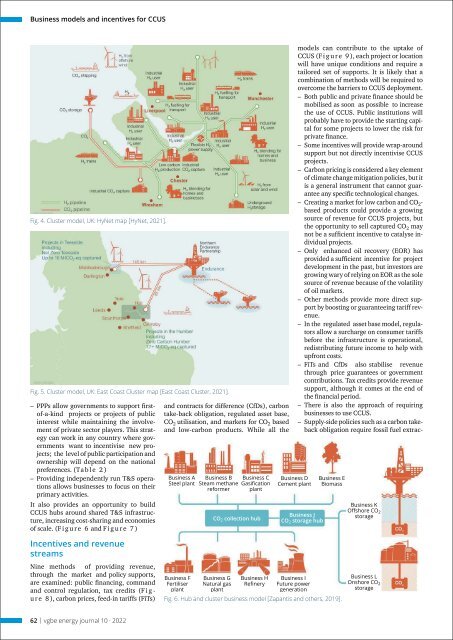vgbe energy journal 10 (2022) - International Journal for Generation and Storage of Electricity and Heat
vgbe energy journal - International Journal for Generation and Storage of Electricity and Heat. Issue 10 (2022). Technical Journal of the vgbe energy e.V. - Energy is us! NOTICE: Please feel free to read this free copy of the vgbe energy journal. This is our temporary contribution to support experience exchange in the energy industry during Corona times. The printed edition, subscription as well as further services are available on our website, www.vgbe.energy +++++++++++++++++++++++++++++++++++++++++++++++++++++++
vgbe energy journal - International Journal for Generation and Storage of Electricity and Heat.
Issue 10 (2022).
Technical Journal of the vgbe energy e.V. - Energy is us!
NOTICE: Please feel free to read this free copy of the vgbe energy journal. This is our temporary contribution to support experience exchange in the energy industry during Corona times. The printed edition, subscription as well as further services are available on our website, www.vgbe.energy
+++++++++++++++++++++++++++++++++++++++++++++++++++++++
Erfolgreiche ePaper selbst erstellen
Machen Sie aus Ihren PDF Publikationen ein blätterbares Flipbook mit unserer einzigartigen Google optimierten e-Paper Software.
Business models <strong>and</strong> incentives <strong>for</strong> CCUS<br />
Fig. 4. Cluster model, UK: HyNet map [HyNet, 2021].<br />
Fig. 5. Cluster model, UK: East Coast Cluster map [East Coast Cluster, 2021].<br />
––<br />
PPPs allow governments to support first<strong>of</strong>-a-kind<br />
projects or projects <strong>of</strong> public<br />
interest while maintaining the involvement<br />
<strong>of</strong> private sector players. This strategy<br />
can work in any country where governments<br />
want to incentivise new projects;<br />
the level <strong>of</strong> public participation <strong>and</strong><br />
ownership will depend on the national<br />
preferences. (Ta b l e 2 )<br />
––<br />
Providing independently run T&S operations<br />
allows businesses to focus on their<br />
primary activities.<br />
It also provides an opportunity to build<br />
CCUS hubs around shared T&S infrastructure,<br />
increasing cost-sharing <strong>and</strong> economies<br />
<strong>of</strong> scale. (F i g u r e 6 <strong>and</strong> F i g u r e 7 )<br />
<strong>and</strong> contracts <strong>for</strong> difference (CfDs), carbon<br />
take-back obligation, regulated asset base,<br />
CO 2 utilisation, <strong>and</strong> markets <strong>for</strong> CO 2 based<br />
<strong>and</strong> low-carbon products. While all the<br />
Business A<br />
Steel plant<br />
Business B<br />
Steam methane<br />
re<strong>for</strong>mer<br />
Business C<br />
Gasification<br />
plant<br />
CO 2 collection hub<br />
models can contribute to the uptake <strong>of</strong><br />
CCUS (F i g u r e 9 ), each project or location<br />
will have unique conditions <strong>and</strong> require a<br />
tailored set <strong>of</strong> supports. It is likely that a<br />
combination <strong>of</strong> methods will be required to<br />
overcome the barriers to CCUS deployment.<br />
––<br />
Both public <strong>and</strong> private finance should be<br />
mobilised as soon as possible to increase<br />
the use <strong>of</strong> CCUS. Public institutions will<br />
probably have to provide the starting capital<br />
<strong>for</strong> some projects to lower the risk <strong>for</strong><br />
private finance.<br />
––<br />
Some incentives will provide wrap-around<br />
support but not directly incentivise CCUS<br />
projects.<br />
––<br />
Carbon pricing is considered a key element<br />
<strong>of</strong> climate change mitigation policies, but it<br />
is a general instrument that cannot guarantee<br />
any specific technological changes.<br />
––<br />
Creating a market <strong>for</strong> low carbon <strong>and</strong> CO 2 -<br />
based products could provide a growing<br />
source <strong>of</strong> revenue <strong>for</strong> CCUS projects, but<br />
the opportunity to sell captured CO 2 may<br />
not be a sufficient incentive to catalyse individual<br />
projects.<br />
––<br />
Only enhanced oil recovery (EOR) has<br />
provided a sufficient incentive <strong>for</strong> project<br />
development in the past, but investors are<br />
growing wary <strong>of</strong> relying on EOR as the sole<br />
source <strong>of</strong> revenue because <strong>of</strong> the volatility<br />
<strong>of</strong> oil markets.<br />
––<br />
Other methods provide more direct support<br />
by boosting or guaranteeing tariff revenue.<br />
––<br />
In the regulated asset base model, regulators<br />
allow a surcharge on consumer tariffs<br />
be<strong>for</strong>e the infrastructure is operational,<br />
redistributing future income to help with<br />
upfront costs.<br />
––<br />
FiTs <strong>and</strong> CfDs also stabilise revenue<br />
through price guarantees or government<br />
contributions. Tax credits provide revenue<br />
support, although it comes at the end <strong>of</strong><br />
the financial period.<br />
––<br />
There is also the approach <strong>of</strong> requiring<br />
businesses to use CCUS.<br />
––<br />
Supply-side policies such as a carbon takeback<br />
obligation require fossil fuel extrac-<br />
Business D<br />
Cement plant<br />
Business J<br />
CO 2 storage hub<br />
Business E<br />
Biomass<br />
Business K<br />
Offshore CO 2<br />
storage<br />
Incentives <strong>and</strong> revenue<br />
streams<br />
Nine methods <strong>of</strong> providing revenue,<br />
through the market <strong>and</strong> policy supports,<br />
are examined: public financing, comm<strong>and</strong><br />
<strong>and</strong> control regulation, tax credits (F i g -<br />
u r e 8 ), carbon prices, feed-in tariffs (FiTs)<br />
Business F<br />
Fertiliser<br />
plant<br />
Business G<br />
Natural gas<br />
plant<br />
Business H<br />
Refinery<br />
Business I<br />
Future power<br />
generation<br />
Fig. 6. Hub <strong>and</strong> cluster business model [Zapantis <strong>and</strong> others, 2019].<br />
Business L<br />
Onshore CO 2<br />
storage<br />
62 | <strong>vgbe</strong> <strong>energy</strong> <strong>journal</strong> <strong>10</strong> · <strong>2022</strong>

















